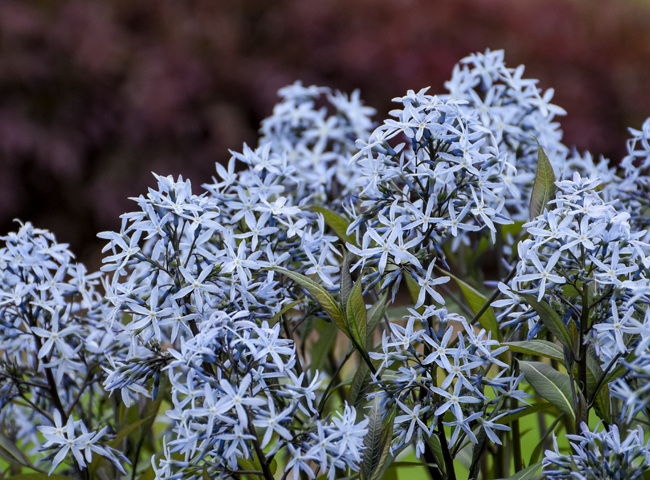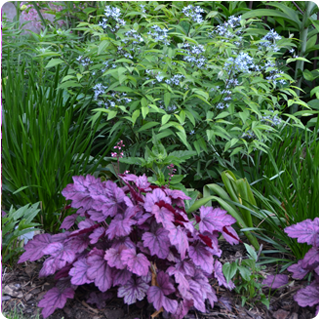‘STORM CLOUD’
AMSONIA
Durable and Stunning by Nature
- The complete package: charming blooms, attractive foliage and easy to grow
- Heat and humidity tolerant
- Grows on windy, exposed sites if not too dry
- Grows in full sun and part sun, meaning a minimum of four hours of afternoon sun
- Measures 24-30” tall x 38-42” spread
- Perennial in USDA zones 4-9
- Pronounced “Am-SOAN-e-uh”
This unique selection of our native bluestar is captivating from the moment its stormy black stems emerge from the ground in early spring. It’s such a striking feature that it sparked the name ‘Storm Cloud’. A puff of baby blue, star-shaped flowers tops the plant every year in late spring. The blossoms contrast beautifully against the deep olive green leaves with silver midribs.
Once the blooms have passed, this durable perennial fills the middle of the border with its attractive, robustly mounded foliage, creating the perfect backdrop against which later blooming plants shine. Other than sunshine and occasional watering if there hasn’t been much rain, ‘Storm Cloud’ will remain self-sufficient for many years to come in both southern and northern landscapes.
how to grow ‘storm cloud’ amsonia
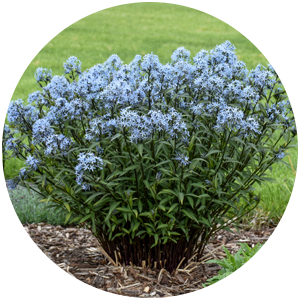
Planting
If you garden in USDA zones 4 through 9, ‘Storm Cloud’ bluestar will grow well for you with one important caveat—this perennial requires 10 to 12 weeks of temperatures below 40°F to bloom. If you live where the winter weather won’t provide that necessary cold, you could grow it simply for the attractive foliage.
This durable perennial holds its own in average soil and all-day sun or part sun, meaning a place that receives a minimum of four hours of afternoon sun. If you grow it in too much shade or in rich soil, you won’t be as happy with it. Though bluestar is fairly drought tolerant once established in your garden, it will flourish with some moisture. While it can certainly handle windy, exposed sites, you may need to water a little more often there.
‘Storm Cloud’ grows more than three feet across as it matures but rarely requires division, so look for a permanent location when planting. You are more likely to notice this perennial in nurseries when it is blooming in the spring, but stores tend to stock it all season. You can plant it any time of year if you can keep it watered well that first season.
If the roots are densely circled around when you take it out of the pot, loosen them up a bit to break the “root memory”. This will encourage them to grow outward instead of continuing to grow in a circular pattern.
No special soil is needed for bluestar. However, if you garden in heavy clay, it’s a good idea to amend with shredded bark or soil conditioner to improve the drainage. Any soil amendments you use should total less than one-third of the soil used to backfill the hole. It would be detrimental to the plant to only use “good” soil in the hole when backfilling.
A good rule of thumb is to dig your hole twice as wide and just as deep as the plant’s rootball. When you backfill the hole, press the soil down with your hand firmly to remove any big air pockets around the roots. Then, water the plant to help the soil settle around it.
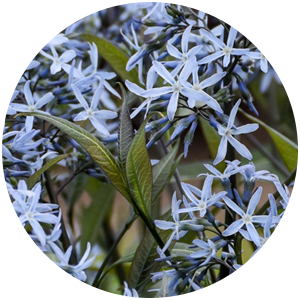
Maintenance
‘Storm Cloud’ bluestar is quite self-sufficient once you take the time to plant it in the right conditions. During the first season, make sure the soil stays fairly moist while the plant is developing a strong root system. It is better to water deeply and less frequently than to water a little bit every day. The former will encourage the roots to delve deeper into the soil which will make the plant more drought tolerant in the long run. Once established, if you notice any crispy brown leaves, that indicates the plant is too dry.
After the baby blue flowers are spent in early summer, you could cut all the stems down to within six to eight inches of the ground. Doing so will result in fuller, mounded foliage, but this kind of trimming is not required for the plant to remain healthy. If you find that rabbits are doing your trimming for you, sprinkle some animal repellent around the base of the plant. You shouldn’t have to worry about deer, as they typically pass bluestar by.
It is natural for bluestar’s foliage to become somewhat paler green during the summer and fall. However, if you feel like this is happening too early or to a greater extent than normal, it could indicate that your soil’s pH is high or that the plant is receiving too much moisture. Reducing the soil’s pH using aluminum sulfate or garden sulfur and applying iron can help green the plant up. If it is planted too close to a sprinkler head, you could reduce the number of minutes on that zone or transplant your bluestar to where the soil stays a little drier.
At the end of the season once the foliage has died back, you can either remove it or leave it lay in place until late winter. It’s best to clear the previous year’s foliage out of the way by early spring to make room for the new stems to emerge.
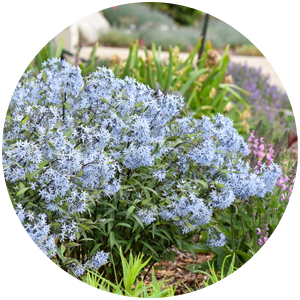
Companions
When deciding what to plant with ‘Storm Cloud’, the most important thing is to look for plants that enjoy similar growing conditions—namely, plants that prefer all-day sun to a minimum of four hours of afternoon sun and ordinary soil of average moisture.
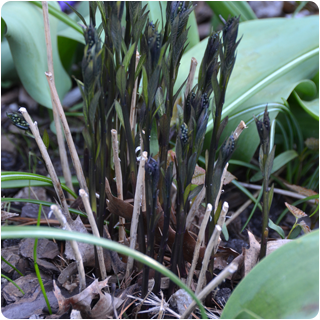
‘Storm Cloud’ Amsonia emerging
Since this plant blooms in late spring, late flowering tulips make good companions. See how it is planted here in front of the tulips? As bluestar’s foliage bushes out, it will hide the bulb foliage as it goes dormant. Other early blooming perennials you could pair with ‘Storm Cloud’ include Decadence® false indigo, Fun and Games® ‘Red Rover’ foamy bells and Sprite spring phlox.
Another idea is to plant ‘Storm Cloud’ with perennials that flower later in the season or have colorful foliage to hold the interest in this part of your landscape. In the example shown here, it is surrounded by bright purple Primo® ‘Wild Rose’ coral bells that shine all season as well as summer blooming coneflowers, ornamental onions and lilies.
top 3 reasons to grow
‘storm cloud’ amsonia
It Gives So Much for So Little
This beauty flourishes from spring through fall with little more than sunshine and occasional watering.
Deer Pass it Right on by
You’re likely to find that Bambi and his friends aren’t interested in ‘Storm Cloud’, and neither are most other garden pests.
It’s a Rock Star from the Earliest Days of Spring
Unlike other bluestars, this variety erupts from the ground in early spring with stormy black stems and blooms soon after with baby blue blossoms.
